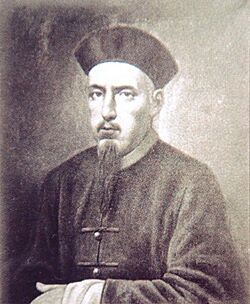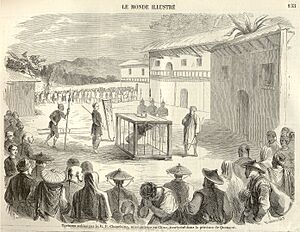Auguste Chapdelaine facts for kids
Quick facts for kids SaintAuguste Chapdelaine |
|
|---|---|

Auguste Chapdelaine.
|
|
| Catholic Missionary | |
| Born | January 6, 1814 French Empire |
| Died | 29 February 1856 (aged 42) Guangxi, Qing Dynasty |
| Venerated in | Catholic Church |
| Canonized | 1 October 2000 by Pope John Paul II |
| Feast | 27 February |
| Auguste Chapdelaine | |||||||||
|---|---|---|---|---|---|---|---|---|---|
| Traditional Chinese | 馬賴 | ||||||||
| Simplified Chinese | 马赖 | ||||||||
|
|||||||||
Auguste Chapdelaine, known in China as Mǎ Lài, was a French Christian missionary. He was part of the Paris Foreign Missions Society, a group that sent missionaries to other countries. He was born on February 6, 1814, and died on February 29, 1856.
His death in China became a major reason for France to join the Second Opium War. French officials used his execution by Chinese authorities as an excuse to start fighting.
About Auguste Chapdelaine
Auguste Chapdelaine was born on a farm in La Rochelle-Normande, France. When he was twenty, he began studying to become a priest. He became a priest in 1843. In 1851, he joined the Institute of Foreign Missions in Paris.
In April 1852, he left France to go to China. He planned to work with the Catholic mission in the Guangxi province. At this time, the Taiping Rebellion was happening in China. This made people suspicious of Christians and foreigners. Foreigners were not allowed to enter certain areas.
After staying in Guangzhou, he moved to Guiyang in the spring of 1854. Guiyang is the capital of the Guizhou province. In December, he traveled with a man named Lu Tingmei to Yaoshan village. This village was in Xilin County of Guangxi. There, he met a local Catholic community of about 300 people. He held his first religious service there on December 8, 1854.
Just ten days after arriving, he was arrested. He was put in the Xilin county prison. He was held captive for about sixteen to eighteen days before being released.
After facing threats, Chapdelaine went back to Guizhou in early 1855. He returned to Guangxi in December of the same year. On February 22, 1856, he was reported to the authorities. This happened while the local court was on holiday. He was arrested in Yaoshan on February 25, 1856. Other Chinese Catholics were also arrested with him. The new local official, Zhang Mingfeng, ordered the arrests.
Chapdelaine was accused of causing trouble. He refused to pay a bribe to be released. He was then put into a small iron cage. This cage was hung at the gate of the jail. The wooden planks he stood on were slowly removed. This caused great strain on his neck muscles. He died a difficult death from suffocation.
After His Death
The leader of the French missions in Hong Kong reported Chapdelaine's death on July 12. The French official in Macau, de Courcy, learned about the execution on July 17. He sent a strong protest to the Chinese Imperial Viceroy Ye Mingchen on July 25. On July 30, he sent a report about the execution to the French foreign office.
The viceroy responded to de Courcy. He said that Chapdelaine had broken Chinese law. This was because he preached Christianity in the interior of China. The 1844 treaty with France only allowed Christians to spread their faith in five treaty ports. The viceroy also claimed the priest was in a rebel area. He said many of Chapdelaine's followers had been arrested for disloyalty. He also stated that Chapdelaine's mission was not about spreading religion.
Because of pressure from France, the official who ordered Chapdelaine's death was later removed from his position. When Britain started fighting China in the same year, France first said it would stay neutral. However, de Courcy made it clear that France supported Britain. This was because of the Chapdelaine incident.
In 1857, another French official, de Bourboulon, arrived in Hong Kong. He tried to get payment for Chapdelaine's execution. He also wanted to change the treaty. But he could not reach an agreement with Viceroy Yeh.
Talks continued into December of that year. On December 14, Viceroy Yeh claimed that the person killed was a member of a secret group. He said this person had a similar Chinese name to Chapdelaine. He claimed this person was executed as a rebel in March. He said this was not the same person as Chapdelaine. He also complained that many French citizens had gone into the interior to preach. He mentioned six missionaries who were arrested and given to French officials. The French embassy found Yeh's answer to be misleading. They saw it as a clear refusal of French demands. French military action began soon after.
The Second Opium War
Historians believe that Chapdelaine's death was used as an excuse. It helped France gain more power in China. France had experienced the deaths of missionaries many times before. But they had not started wars over it.
Britain was expected to win its war with China. France wanted to gain its own power in China. These reasons, along with France's usual policy of not starting wars over missionary deaths, led many historians to believe that Chapdelaine's death was simply an excuse for France to expand its empire.
Lord Elgin, a British official, commented on France's demands before the war. He noted that the French ambassador had a "much better case of quarrel" than Britain. He meant that France's reason for war sounded more convincing.
After the war, the Sino-French Peking Convention was signed. Article Six of this treaty gave Christians the right to spread their faith in China. It also allowed French missionaries to own property there.


